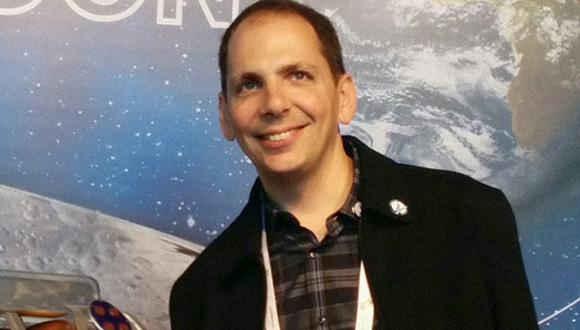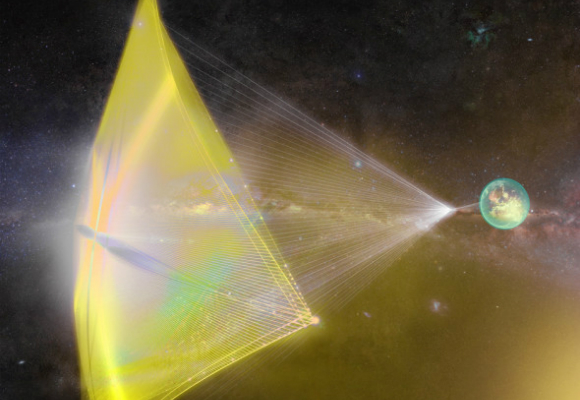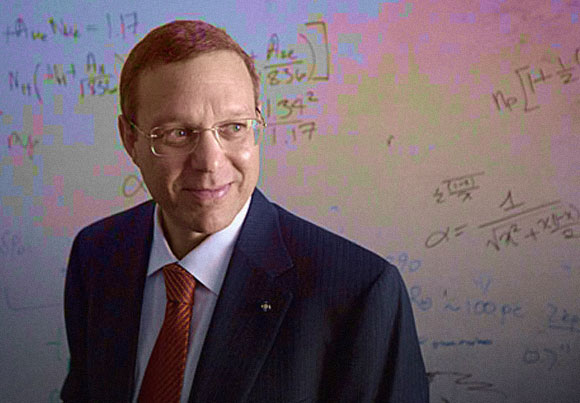Even the most sophisticated of spacecraft can barely reach the edge of our solar system. Could we one day break this boundary and send humans to distant solar systems?
It’s been almost six decades since the beginning of the space age, yet humanity remains akin to a person trapped indoors, yearning to break free. Merely a few hundred astronauts have ventured to the balcony of our world - low Earth orbit - while a mere thirty succeeded in reaching our celestial house-garden - the Moon. Among these few, only 12 have been privileged to walk upon its surface.
A few unmanned spacecrafts have managed to explore our planetary neighbors: Mars, Venus, Jupiter, and Saturn, and only three unmanned spacecraft have embarked on lengthier odysseys along our cosmic street. The two Voyager spacecrafts launched in the late 1970s, now located on the outskirts of the solar system, and the New Horizons spacecraft, which journeyed past Pluto in 2015, and which may reach the edge of our solar system in the current decade.
Yet, our solar system is but a speck in the vast cosmic expanse of a multitude of others. Our galaxy, the Milky Way, contains roughly 200 billion suns, many of which are likely orbited by planets. Beyond the Way, conservative estimates speak of a hundred billion galaxies scattered throughout the universe. These orders of magnitude are very difficult to comprehend. For perspective, the diameter of the Milky Way spans approximately one hundred thousand light years. That is, if we move at the speed of light, a journey from one end to the other would take us 100,000 years.
Our nearest stellar neighbor, Proxima Centauri, lies 4.25 light-years away. That is, at the speed of light, it would take us more than 4 years to reach it and the terrestrial planet discovered orbiting it, which is speculated to be potentially Earth-like. But even our fastest spacecraft remain very far from the speed of light. If the New Horizons spacecraft, which travels at over 1 million kilometers a day, were to try to reach Proxima Centauri, the journey would take it about 70 thousand years!
Can humanity ever approach light-speed travel? Could we visit other solar systems? Answering these questions may not be merely about satisfying our curiosity; it could be a matter of survival. After all, the Earth’s lifespan is finite, with its existence expected to extinguish in roughly 5 billion years, as the sun eventually swells and consumes it before eventually collapsing. Yet, long before that, threats of annihilation due to a possible collision with a large asteroid or a man-made catastrophe might force mankind to find a new cosmic address.
In recent decades, several innovative technologies have emerged that could redefine space exploration and possibly allow us to break through the boundaries of space. While some remain in the realm of imagination, others are approaching the feasible end of the scale, even if their implementation may demand many more years of research and development.
The World’s Most Precious Material: Amtimatter
In 1028, British physicist Paul Dirac predicted the existence of an enigmatic particle, the anti-electron. While formulating equations describing the electron’s behavior, Dirac came to the conclusion that these equations also permitted the existence of a particle identical to the electron in every way, but carrying a positive charge instead of a negative one. In subsequent years it became clear that such counter-particles are not mere mathematical curiosities, but actually exist in reality. In fact, beyond anti-electrons (or positrons), anti-protons also emerged, capable of forming complete atoms of antimatter. When an antiparticle meets its counterpart this results in their mutual annihilation, releasing a tremendous amount of energy in the process.
The energy released by this encounter of matter and antimatter can supposedly propel rockets and spacecraft at incredible speed. Physicists think that just four milligrams of positrons is enough to allow a spacecraft to reach the planet Mars in a few weeks, instead of the current nine months. But obtaining such quantities of antimatter is not a simple matter. Physicists from large particle accelerators such as CERN are capable of producing tens or hundreds of atoms of antihydrogen, but this is far from a sufficient quantity for practical applications.
Antimatter is now considered the world's most expensive product with the price of one gram estimated in the trillions of dollars, although no one can produce a quantity even close to this. The tremendous energy required to produce antimatter has downplayed interest even more. Antimatter engines can become an important tool for powering spacecraft, but only if an effective way to produce it will be found, or alternatively we will develop the means to collect antimatter in space.

An energy with tremendous power, yet at a staggering cost in the trillions of dollars. Simulation of an antimatter rocket | Photo Credit: NASA
A Nuclear Explosion in Space
Another possible way to propel spacecraft to vast distances involves harassing nuclear energy. Modern-day satellites and spaceships deploy nuclear generators to produce electricity. Such devices are powered by radioactive materials, typically plutonium, utilizing the heat generated during their decay to produce power. Such nuclear generators provide electricity for operating the spacecraft’s instruments, especially during extended missions far from the sun’s rays, where there is not enough sunlight to produce solar energy.
While these radioactive generators are designed for prolonged operation, they lack the thrust necessary for spacecraft propulsion. Such thrust could potentially be derived from a full-scale nuclear explosion, akin to that of an atomic bomb.“You can build a spaceship with a large radiation shield at the back through which you can detonate bombs. The radiation from the explosion will push the spaceship forward, and with a series of such detonations you can attain significant velocity,” said Yoav Landsman, former chief space engineer at SpaceIL, an Israeli non-profit organization aimed at landing a robotic spacecraft on the Moon and Deputy Mission Director of its “Beresheet” mission. “It’s not a bad use of atomic weapons, compared to the alternative, and it is even theoretically feasible, but probably not practical in the foreseeable future, primarily due to the safety concerns.”
Calculations made in the 1950s and 1960s suggested that such a nuclear-propelled spacecraft could attain one-tenth of the speed of light - a speed that would allow it to reach Pluto and come back within a single year. But even at such velocity, it will still take several decades to reach a neighboring solar system. Furthermore, for manned missions, radiation poses a real threat. Initial blueprints for such spacecraft ultimately remained on paper due to safety considerations and the ban on nuclear testing.

Not a bad use for an atomic bomb, but probably not applicable for the time being. Yoav Landsman | Photo Credit: private album
A Fusion Reactor And A Funnel
The process opposite to the nuclear fission process that powers atomic bombs is that of nuclear fusion. Instead of causing the nuclear disintegration of a large atom such as uranium, nuclear fusion merges small atoms, such as hydrogen, into the nucleus of a slightly larger atom, such as helium. It is the same process that perpetually powers the sun, producing enormous amounts of energy. Notably, fusion is also infinitely safer than the fission process since it does not emit radioactive substances as byproducts.
The most significant disadvantage of nuclear fusion is the high initial energy requirement to kickstart the process. In hydrogen bombs, which produce hundredfold more energy than an atomic bomb through nuclear fusion, the explosion process starts with a nuclear fission reaction, which provides the energy needed for fusion. Scientists’ much fabled concept of cold fusion, which would sidestep the need for the tremendous heat of the sun or of a nuclear explosion, will probably remain in the realm of dreams.
A nuclear fusion reactor holds promise for solving the problem of high-speed space flight, because it provides even more energy than atomic bombs without the accompanying safety concerns. Moreover, space is not entirely devoid of matter, it contains quite a lot of hydrogen atoms. If we could devise a mechanism to collect these atoms and funnel them into a fusion engine, it would allow for virtually boundless energy to propel high-velocity space voyages.
The originator of this idea, Robert Bussard, calculated that such an engine, known as a ramjet engine, weighing a thousand tons, could sustain a constant acceleration of 1g - a force equivalent to Earth's gravitational pull, to which our bodies are accustomed. A year-long journey at such an acceleration would propel the spacecraft to approximately 77% of the speed of light, a velocity that would make interstellar travel a conceivable possibility.
Moreover, according to Einstein's theory of relativity, time moves slower as the speed of movement approaches the speed of light. Consequently, a spacecraft traveling at such velocities could in principle traverse the entire observable universe within the lifespan of its crew members, even as billions of years transpire outside.
American physicist Michio Kaku noted in his book “The Physics of the Impossible'' that to collect sufficient hydrogen atoms for this kind of propulsion, a spacecraft would need a massive funnel, approximately 160 km in diameter. It is theoretically possible to assemble such a facility in space, provided a zero-gravity space environment, and to produce a space engine that could propel humanity to the edge of the universe without the need for additional fuel. However, the pivotal challenge remains constructing an efficient hydrogen fusion reactor that doesn’t demand more energy for its operations than it generates. Until this obstacle is overcome, the energy challenges will persist to trouble us on Earth, and boundless space travel aboard colossal spaceships will remain a distant dream.

A giant funnel for collecting hydrogen and a nuclear fusion reactor. Simulation of the ramjet | Photo Credit: NASA
Anchors Aweigh, Hoist the Sail
Presently, solar radiation serves as a means to generate electricity in numerous spacecraft and satellites, but one of the more interesting initiatives uses solar radiation to generate space propulsion. The sunlight exerts a small but constant pressure, which can be harnessed for space travel with the help of a suitable sail, which would reflect part of the radiation and thus be propelled onward with the help of the sun. Such a sail must be very lightweight and proportionately much larger than the spacecraft and would also require an efficient method to deploy it in space. This operation is not so trivial in space compared to performing it on Earth, due to the lack of air.
After several failed attempts in this domain, in 2010 Japan successfully launched the IKAROS spacecraft (short for Interplanetary Kite-craft Accelerated by Radiation Of the Sun). Drawing inspiration from Greek mythology, this spacecraft was named after Icarus, the son of Daedalus who famously crafted wings together with his father to escape imprisonment. However, in the tale, Icarus meets a tragic end after venturing too close to the sun, which causes the wax holding his feather together to melt. The IKAROS spacecraft is propelled by a sail spanning 196 square meters (14 x 14 meters). Some sections of this sail are covered with a thin layer of LCS, enabling them to change color and allowing dynamic alteration of radiation reflection, and consequently, the spacecraft’s trajectory.
After a seven-months voyage, IKAROS passed near planet Venus, thus completing the first interplanetary flight using a solar sail, subsequently entering into orbit around the sun. The American Space Agency and other international space entities, continued to experiment with this technology, focusing mainly on compact spacecraft.
Landsman elaborates on the prospects and challenges of solar sails: “As we envisage scaling up from small spacecraft to giant manned vessels using solar sails, the mass of the spacecraft becomes a pivotal factor. A larger spacecraft mandates an even larger sail, potentially spanning several kilometers, or even hundreds of square kilometers. This poses a monumental challenge,” he explains. “However, one undeniable advantage of such a spaceship is that it doesn’t consume fuel. Another challenge however, is in decelerating it after it has gained momentum, and naturally, in returning it home. This challenge might be surmounted by harnessing radiation from distant suns encountered on such a voyage.”

The spacecraft is steered using the changes in color. Simulation of IKAROS in space | Photo Credit: Andrzej Mirecki, Wikipedia
A laser that still does not exist
If radiation can accelerate a spacecraft sail, why settle for solar radiation? An exciting new venture that generated a lot of public- and media-interest this year, has suggested launching some relatively small spacecrafts by propelling them with a powerful laser beam. “Spaceships the size of a smartphone, with a sail of a a few square meters and a strong laser beam with a diameter of several meters that focuses on just the sail, will be able to reach one-fifth the speed of light, and therefore reach the solar system of Proxima Centauri within 20 years,” explains Professor Avi Loeb, Head of the Department of Astronomy at Harvard University and Head of the Advisory Committee for Breakthrough Starshot, a new venture financed by Russian tycoon Yuri Milner, along with partners like Professor Stephen Hawking and Facebook founder, Mark Zuckerberg.
The plan is to deploy the solar sail crafts in earth prbit, after sending them via a conventional rocket, and then to push them away with a Earth based laser for a few minutes, until they accelarate to their full speed. “Currently there is no such laser, that produces the energy levels required for such feat, which is similar to the energy required for a space shuttle launch. But it has been made possible thanks to the discovery in recent years of that we can merge several small rays to one powerful beam, and thanks to the advancement of miniaturization of electronics,” said Loeb. “Currently chemically-driven spacecrafts obtain a speed of 15-20 kilometers per second, and it has hardly progressed since the beginning of the space age. We want to be a thousand times faster, using a brief laser thrust on each spacecraft. This will be a huge leap forward - and it is not impossible.”
Space enthusiast Milner was named Yuri after the first cosmonaut, Yuri Gagarin. He invested 100 million dollars for feasibility studies that should take several years. This testing phase includes the examination of the effectiveness of such a system in a vacuum chamber on Earth to see whether the spacecraft can reach the desired speed. The projects total cost is expected to exceed 10 billion dollars, but the team is certain that if the technology would prove feasible, it will not be difficult to raise the sum from eager investors.

A speed a thousand times greater than with ordinary chemical propulsion. Simulation of the focused laser beams | Photo Credit: Starshot Breakthrough
Loeb and Milner, both 55, hope to see their spaceships make it to the Centauri solar system in their lifetimes, despite the twenty-years flight time with the addition of four years for the data signals of the Centauri spacecraft to be sent back to us. Another limitation of the spacecraft is its inability to return, stop or even to slow down when it reaches its destination. “It just passes next to the solar system and continues on its way,” said Loeb. “But the information that will be sent will open a new window for information about the nearest solar system.”
Loeb is convinced that small sail spacecraft are the key to studying the universe, and even in our search for a home for humanity in the distant future. “You can explore all sorts of things with telescopes, but there is no substitute for visiting new places, and it can be done with a space sail, just as Columbus did in a sailing ship in discovering the New World. The spacecraft will better enable us not only to reach other solar systems, but also to better explore our solar system. We can send spacecraft to the moons of Jupiter within less than a day and Pluto in three days - today such tasks require a journey of many years.”
Perhaps sail spacecraft will open up the universe, but the possibility that people will fly them and leave the solar system is even further still. “To launch such manned missions, of many years duration, a spacecraft of thousands of tons is required, and vessels of this magnitude will require nuclear fusion propulsion,” admitted Loeb. “One of the advantages of our system is the tiny size of the vessels, and will be at least fifty or a hundred years before we know if it is possible to develop such technology for manned flights. I assume that people will be able to leave the solar system in the distant future, but it may not be necessary. It might be that technology will allow us to combine human life with robotic components, and instead of sending people to distant places we could send just our minds over there.”

A giant leap – but a possible one. Prof. Avi Loeb | Photo Credit: Kris Snibbe, Harvard Gazette
Flying cities
Even if the futuristic technologies become a reality, it is clear that manned flights to the outer reaches of the universe will require huge spacecraft - “flying cities” of sorts, where people could lead full lives for many years. “I don’t think anyone would agree to travel for such a long period, even within a structure like the International Space Station,” Landsman says. “It will take something completely new - giant space ships, which according to our existing technologies, will have to be sent into space in segments and assembled in Earth orbit. And there may be other methods - such as freezing or anesthetizing of astronauts for most of the flight.”
Whether the inhabitants of these colossal vessels will be in a state of wakefulness or deep sleep, the design process of such flying cities must take into consideration the multifaceted impacts of prolonged space travel on the human body. A prolonged stay at conditions of zero-gravity leads to muscle deterioration, bone density reduction, and compromises other vital organs, even from mere months in space. For multi-year space travel, it would be absolutely necessary to find a solution for this problem, for example by creating an artificial gravitational force in a portion of the spacecraft. Other challenges that can make such a journey highly challenging is radiation, which is dangerous both for humans as well as for spaceship equipment, and the possibility of collision with meteors or other cosmic entities. The solution would mean fortifying the spacecraft with adequate protective shielding, which would immensely increase the weight of such vessels, making them more cumbersome and driving up costs.
Continuing Innovation
Alongside the relatively accepted theories presented here, new ideas for efficient energy utilization for long-range flights are emerging. One such proposal centers on the electromagnetic drive (EM Drive) - an engine designed to generate thrust without consuming fuel or producing emissions. The idea is based on waves trapped in a closed system, bouncing between mirrors without losing energy. Occasionally, these waves interact with photons (particles of light) that come from the outside, producing thrust without depleting the system’s resources.
The idea seemingly defies the law of conservation of energy and matter, yet its developer Roger Shawyer ardently asserted that it operates within the bounds of physical laws. In fact, the American Institute of Aeronautics and Astronautics (AIAA) published a peer reviewed research article on the topic of EM drive in one of its journals in 2016.
Another idea came from Canadian entrepreneur Charles Bombardier, who suggested that since most of the energy in space flight is wasted on acceleration and deceleration, a solution might be a spacecraft akin to a long train, perpetually shuttling between Earth and Mars. After the launch, it will capitalize on planetary gravitational force for initial acceleration, potentially reaching speeds of about 1% of the speed of light (about 3,000 km per second), which will allow it to travel the distance between Earth and Mars in just two days. Propelled by the energy derived from their orbit, it would continue to move at this speed, picking up or dropping off payloads or hitching spacecraft without altering its pace.
Unfortunately, although the idea sounds tempting, Bombardier does not explain how such a space train would be controlled. It is also not clear how spacecraft would be able to catch up with the train at such great speeds in order to “hitch a ride”. Without answers to these questions, the space train will remain in the realm of fantasy.
Obeying The Laws of Physics
If we want to make space travel as commonplace as taking a drive, we must find a way to exceed the speed of light - a barrier deemed insurmountable. Notions of achieving such feats hinge on the manipulation of the fabric of space-time and and the creation of distortions in it, whether by stretching of the universe in one place and contracting it at another, or by invoking a “wormhole” - a hypothetical rift in space-time that allows us to pass through it to distant realms in the universe or even to entirely different universes.
“The idea that such things are possible is nothing more than a speculation based on Einstein’s equations, but it is not clear at all if it is theoretically feasible, and even more so, whether it can be carried out practically,” explains Loeb. “In the meantime, there is no substitute for travel than that of moving between two points in a straight line and at a speed that does not exceed the speed of light. In principle, we can achieve flight at the speed of light just by accelerating a spacecraft at 1g continuously for a year. The problem is that with current technological limitations, this would demand more fuel than the entire MilkyWay contains.” Even if we scale back our ambitions and embark on a less ambitious journey, such as a manned mission to the nearest solar system within a span of decades, such an endeavor demands colossal financial resources. “While I’d love to witness such a journey during my lifetime, there isn’t much hope to hold on to,” ruminates Landesman. “Perhaps if the small sail-powered spacecraft discover something intriguing on a planet such as Proxima Centauri, to make us realize that we must get there ourselves, it might catalyze the outpouring of investment in this direction.”
So, if anyone in the Centauri system or elsewhere in the universe is reading this article. We’re eager to visit. Really! A nudge in the right technological direction, or even a touch of financial assistance would be highly appreciated.
